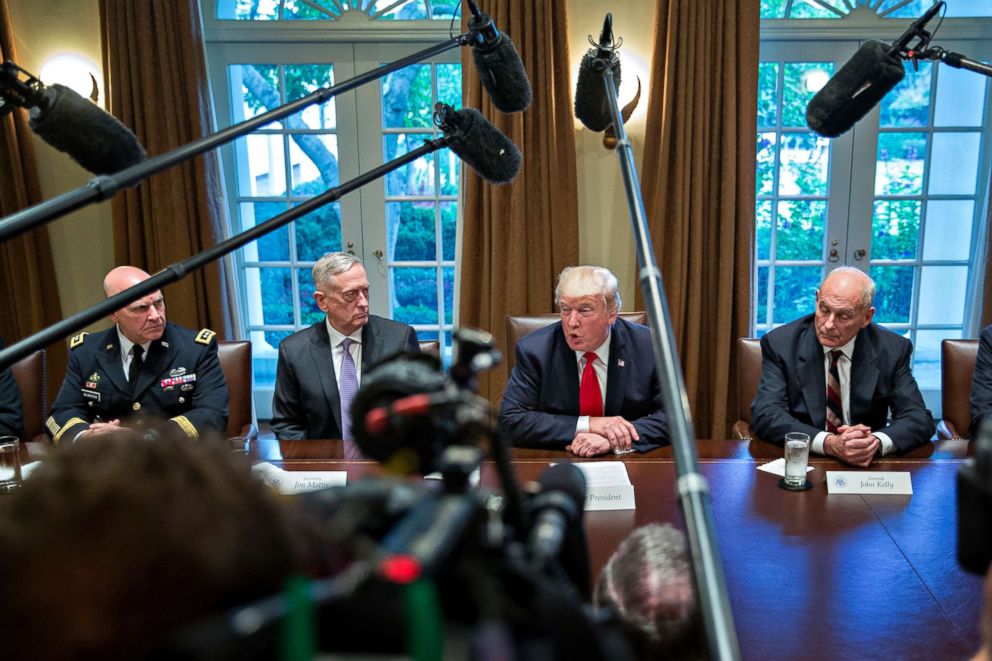Fact Check Friday: Trump fires off flurry of falsehoods in new year's first Cabinet meeting
The president made multiple false statements over an hour and a half.
President Donald Trump kept up his habit of making false claims in the first abbreviated week of 2019, starting the new year by dispensing a dizzying supply of factually dubious and outright false statements.
Over the course of an hour-and-a-half-long press availability during his first Cabinet meeting of 2019, the president offered a puzzling justification for the Soviet invasion of Afghanistan, grossly inflated the cost of illegal immigration and the number of people in the country without proper documentation, claimed he “essentially” fired his former secretary of defense (who actually resigned over policy disagreements with the commander in chief), and falsely claimed the U.S. spends more in Afghanistan in one month than he is requesting for his desired border wall.
Trump's puzzling recollection of why the Soviet Union invaded Afghanistan
In making the case that an unlimited timeline on military presence in Afghanistan serves only to damage the U.S., President Trump began a riff on an argument he often used during the 2016 campaign: pointing to the Soviet Union’s invasion of Afghanistan in 1979.
“Russia used to be the Soviet Union. Afghanistan made it Russia, because they went bankrupt fighting in Afghanistan,” Trump said.
While several historians reached by ABC News acknowledged that the Afghanistan war was costly for the U.S.S.R., there was considerable disagreement with the president’s contention that the invasion contributed to the Soviet Union’s collapse.
“No one can even remotely argue that the war in Afghanistan had anything to do with the break-up of the Soviet Union,” said Sergey Radchenko, a professor of International Politics at Cardiff University and Global Fellow at the Wilson Center. “The Soviet Union fell apart partly because of runaway forces of centrifugal nationalism, which the particular structure of the Soviet state ironically enabled, and partly because certain political actors in the largest republics -- especially Russia -- sought to gain power by weakening the center's authority.”
“It was only a small fraction of the Soviet overall defense expenditure,” Radchenko added.
Artemy Kalinovsky, an assistant professor at the University of Amsterdam and research associate at the Cold War Studies Program at the London School of Economics and Politics, largely agreed with Radchenko.
“The war was not a significant drain on the Soviet Union either in hard military terms or in fiscal terms,” Kalinovsky told ABC. “Reporting on the war in the late 1980s did contribute to political polarization, led to a more critical attitude towards the military on the part of the public, and helped alienate some of the military elite from Mikhail Gorbachev. But the Afghanistan war was not a major factor in the nationalist mobilizations of that era.”
In his Cabinet meeting, Trump also made the argument that Russia invaded Afghanistan primarily because, “terrorists were going into Russia,” adding, “they were right to be there.”
The latter claim that the U.S.S.R. was “right” to invade Afghanistan flies in the face of decades of past U.S. policy, especially considering the U.S. intervened in Afghanistan at the time to aid the mujahideen in their fight against the Soviets.
“That is obviously a big departure from the way U.S. policymakers - Democrats and Republicans - have ever talked about the Soviet intervention,” Kalinovsky said. “It is also not the way most Russians -- including many military leaders -- saw things, although recently there has been more of an effort to justify the initial intervention.”
The Soviet pretext at the time of the invasion was to offer support to the communist government in their fight against the anti-Communist mujaheddin.
But it was the president’s claim of ‘terrorists’ going into the U.S.S.R. to back up his belief that Soviet intervention was justified that truly perplexed historians.
“This claim is utterly preposterous,” Radchenko said. “The Soviet invasion of Afghanistan was a complex affair, but the notion that some terrorists were infiltrating the U.S.S.R. from Afghanistan has no basis in reality.”
“When the Soviets intervened in Afghanistan they were not worried about terrorism or Islamism of any sort,” Kalinovsky added. “They were mostly worried that an unstable Afghanistan would be an opportunity for the United States to threaten the USSR on its southern border.”

Does illegal immigration cost the US $250 billion each year?
Near the beginning of the Cabinet meeting, President Trump repeatedly stressed the need for a wall along the U.S.-Mexico border to curb illegal immigration.
Repeating a claim he made in a tweet about one month prior, he argued that if Congress provided him with his demands for $5.6 billion in border wall funding it would “pay for itself in a month or two.”
“Because we lose pretty close to $250 billion on illegal immigration,” Trump said. “And I would say that it could be on a monthly, or a couple of months, it would pay for the wall, pay for what we're talking about.”
But that claim isn’t true. The White House did not immediately respond to questions asking for clarity on where the president first discovered this statistic, but of multiple independent analyses measuring the economic costs of illegal immigration, none come close to the $250 billion figure floated by Trump.
A 2013 report from the conservative Heritage Foundation estimated that undocumented immigrant households cost the U.S. “around $54.5 billion” per year in net fiscal burden.
And a 2017 report from the Center for Immigration Studies, which typically advocates for aggressive measures to curb illegal immigration, imagined the following scenario of the wall “paying for itself” as the president has described.
“If a border wall stopped between 160,000 and 200,000 illegal crossers — 9 to 12 percent of those expected to successfully cross in the next decade — the fiscal savings would equal the $12 to $15 billion cost of the wall,” the study said.
But that estimate is still far away from the “$250 billion” the president claims that illegal immigration costs the U.S. per year.
Trump falsely claims 30-35 million undocumented immigrants are living in US
President Trump also used his extended time in front of cameras to make a claim widely inflating the current number of undocumented immigrants living in the U.S.
“Look, when you hear -- I've been hearing 11 million; I've been 12 million; I've been hearing 35 million,” Trump said. “I used to hear 11 million all the time. It would always stay right at 11.”
Trump added, “It's probably 30, 35 million people.”
But that claim is false.
Homeland Security Secretary Kirstjen Nielsen, testifying before the House Oversight Committee on Dec. 20, said her department currently estimates there are “somewhere” between 11 million and 22 million undocumented immigrants currently residing in the U.S.
Pew Researchers have generated much more conservative estimates, however, releasing research that they claim shows the number of undocumented immigrants has actually decreased leading up to 2016 from its peak of 12.2 million in 2007.
Trump attempts to revise how and why Mattis departed
President Trump was the first to announce by Twitter last month that James Mattis would be “retiring” as secretary of defense. And officials within the administration made clear at the time that Mattis’ resignation was not forced but a decision he made of his own accord.
But at Wednesday’s Cabinet meeting, President Trump sought to change that narrative by asserting he “essentially” fired Mattis.
“President Obama fired him, and essentially, so did I,” Trump said, criticizing Mattis’ management of the U.S. military presence in Afghanistan, where President Trump is now weighing a troop drawdown.
“What’s he done for me? How has he done in Afghanistan? Not too good. Not too good. I’m not happy with what he’s done in Afghanistan. And I shouldn’t be happy,” Trump said.
Trump’s attempt to change the story comes after a vast body of reporting that Mattis resigned in protest over his strong disagreements with the president’s announced decision to withdraw troops from Syria within 30 days, a timetable the president has since walked back to allow for a more gradual drawdown.
In his resignation letter made public, Mattis did not hide his philosophical disagreements with the president, writing, “Because you have the right to have a Secretary of Defense whose views are better aligned with yours on these and other subjects, I believe it is right for me to step down from my position.”

Trump claims the US spends more in a month in Afghanistan that total cost of border wall
Trump also argued that the U.S. spends more in one month in Afghanistan than the $5.6 billion figure he’s demanding for a southern border wall in the ongoing shutdown fight.
“We spend in Afghanistan more in one month than what we’re talking about for the wall,” Trump said, citing the $5.6 billion figure he’s requesting.
But his numbers are off.
Last February, Pentagon official Randall Schriver testified that the war in Afghanistan cost about $45 billion each year. That would put the monthly cost of the Afghan war at $3.75.
So, while the U.S. is still spending a considerable amount in Afghanistan on a monthly basis, it is below the $5.6 billion figure cited by the president.




